Study on the Vertical Stability of Drilling Wellbore under Optimized Constraints
Abstract
1. Introduction
2. Theoretical Methodology
2.1. Force Analysis of Wellbore under Optimized Construction Method
- (1)
- The material of the wellbore is completely elastic, obeying the law of Huke;
- (2)
- The displacement and deformation of the wellbore during flexion is small;
- (3)
- The effects of friction and bonding between the wall and mud are not taken into account.
2.2. Building the Total Potential Energy Function
2.3. Derivation of Equations for Critical Depth
2.3.1. Necessary Condition
2.3.2. Sufficient Condition
2.3.3. Equation for Critical Depth of Wellbore Destabilization
3. Analysis and Discussion
3.1. Comparison Analyses
3.2. Discussion on Critical Depth Influence Factors
3.3. Multi-Factor Sensitivity Discussion
4. Numerical Calculation Verification
4.1. Principles of Stability Numerical Calculation and Numerical Models
- (1)
- Definition of nodes and node sets. The node types are defined by *Node and Nset. A total of 15,433 nodes are defined in the entire wellbore model, and the height of wellbore model is 638.084 m. The nodes at the bottom of the wellbore are named “BOTTOM”, and the nodes at the top of the wellbore are named “TOP”.
- (2)
- Definition of elements and elements sets. In this structure, the elements in the bottommost of the wellbore are defined using three-node triangular linear film strain linear shell elements, referred to as S3R. All other elements are specified to use four-node quadrilateral linear reduced integration shell elements, referred to as S4R.
- (3)
- Define surfaces. Surfaces are defined by the *Surface command, which describes the faces composed of elements. For all elements, their inner surfaces are named “In”, and their outer surfaces are named Out.
- (4)
- Define materials. Materials are defined by the Materials command. The wellbore structure is made of reinforced concrete. The concrete is graded C70. The elastic modulus of concrete is 38.15 GPa, and its Poisson’s ratio is 0.285. The reinforcing steel has an elastic modulus of 210 GPa, and its Poisson’s ratio is also 0.285.
- (5)
- Define shell parameters. Defined by the Shell section command, the thickness of the shell is 0.85 m.
- (6)
- Definition of loads. The height of counterweight water is 333.3 m, and the height of mud is 638.084 m.
- (7)
- Define boundaries. The *Boundary command is used to define boundary conditions. We define the corresponding constraints on BOTTOM and TOP.
- (8)
- Define buckling. Buckling is defined by the Buckle Step command. We set the number of eigenvalues requested to five.
4.2. Comparative Analysis of Numerical Models
5. Conclusions
- (1)
- In this paper, it is proposed that cement mortar can fill the the bottom of the well in advance to improve the stability of the wellbore before the wall is suspended and sunk to the bottom. According to the contact characteristics of the bottom of the wall after optimization, the wall cylinder is regarded as an equal-section compression rod hinged at the upper end and solidly supported at the lower end, and based on the mechanism of cusp catastrophe characteristics, the critical depth of instability of an equal-section drilling wall in a non-full-water state is deduced from catastrophe theory.
- (2)
- Compared with the traditional method, the critical depth of the wellbore structure after the optimization method can be increased by 41.39 ± 5%. Through numerical simulation using a sub-well as an engineering example, the eigenvalue of the traditional method is 0.9978, which is smaller than 1, indicating that the wall is unstable, while the eigenvalue of the optimization method is 2.7471, which is larger than 1, indicating that the wall is stable, which is in line with the theoretical calculation. Both the theoretical and numerical analysis reveal that the optimization method is reliable and applicable.
- (3)
- The critical depth of the wellbore structure by using optimization measures is influenced by multiple factors. It increases with the increase in the elastic modulus and the thickness of the wellbore, decreases with the increase in the self-weight of the wellbore, and shows a trend of first decreasing and then increasing with the increase in the height of counterweight water.
- (4)
- The critical depth of the wellbore structure by using optimization measures is influenced by multiple factors to varying degrees. The degree to which they are affected in descending order is elastic modulus, counterweight water height, self-weight of the wellbore, and thickness of the wellbore.
- (5)
- In practical engineering, it is of great practical significance to use high-strength steel with a higher modulus of elasticity or increase the height of appropriate counterweight water and reduce the thickness of internal and external steel plates to improve the stability of the wellbore.
Author Contributions
Funding
Institutional Review Board Statement
Informed Consent Statement
Data Availability Statement
Conflicts of Interest
References
- Zhao, S.; Chen, X.; Zhao, X. Analysis of current status and development direction of coal mining technology in China. In Proceedings of the 4th International Conference on Energy Science and Applied Technology (ESAT 2018), Chongqing, China, 29–30 December 2018. [Google Scholar]
- Gustavo, A.; Peter, G.; Jürgen, K.; Jaime, R.O. Sustainability of coal mining. is Germany a post-mining model for Colombia? Resour. Policy 2023, 81, 103358. [Google Scholar]
- Fares, A.; Kirill, P.; Vitaly, Z.; Sergey, Z. Development of a Software Tool for Visualizing a Mine (Wellbore) in the Industrial Drilling of Oil Wells. Processes 2023, 11, 624. [Google Scholar]
- Zou, Y.; Zhu, X.; Wu, X. Experimental Study on Enhancing Wellbore Stability of Coal Measures Formation with Surfactant Drilling Fluid. Chem. Technol. Fuels Oil 2021, 57, 179–187. [Google Scholar] [CrossRef]
- Zhang, G.; He, S.; Tang, M.; Kong, L. The mechanism and countermeasures of inclined well wellbore instability in Dibei deep coal seam. J. Pet. Explor. Prod. Technol. 2022, 12, 2833–2848. [Google Scholar] [CrossRef]
- Liu, M. Technical study on horizontal coalbed methane wells in high dip strata in the Urumqi Mining Area. China Coalbed Methane 2020, 17, 24–28. [Google Scholar]
- Wu, B.; Wang, J.; Zhong, M.; Xu, C.; Qu, B. Multidimensional Analysis of Coal Mine Safety Accidents in China—70 Years Review. Mining Metall. Explor. 2023, 40, 253–262. [Google Scholar] [CrossRef]
- Zhang, X.; Zhang, S. Research on the Path of Constructive News of Disaster Report in the Era of Convergence-Media—Taking the Coal Mine Collapse Accident in Alxa Left Banner, Internal Mongolia as an Example. Acad. J. Humanit. Soc. Sci. 2023, 6, 116–122. [Google Scholar]
- Ashena, R.; Elmgerbi, A.; Rasouli, V.; Ghalambor, A.; Rabiei, M.; Bahrami, A. Severe wellbore instability in a complex lithology formation necessitating casing while drilling and continuous circulation system. J. Pet. Explor. Prod. Technol. 2020, 10, 1511–1532. [Google Scholar] [CrossRef]
- Wang, Y.; Song, L.; He, Y.; Wang, G.; Wang, Q.; He, Y.; Gao, J. Similar simulation test study on the influence of mining on shaft deflection of deep soil based on hydraulic permeability model. Energy Explor. Exploit. 2023, 41, 19–43. [Google Scholar] [CrossRef]
- Liu, Z.; Song, C.; Cheng, S.; Hong, W.; Jing, G.; Li, X.; Wang, L.; Zhao, J. Development history and status quo of raise boring technologies and equipment in China. IJCST 2021, 49, 32–65. [Google Scholar]
- Jia, D.; Lan, S.; Wang, X. Evolution Characteristics of Concrete Support Strength of the Inclined Shaft Wall in Xiaobaodang Coal Mine. Energy Technol. Manag. 2024, 49, 141–145. [Google Scholar]
- Łukasz, B. The analysis of shaft sinking progress as a function of technical and organizational parameters. Multidiscip. Asp. Prod. Eng. 2019, 2, 203–212. [Google Scholar]
- Eldert, J.V.; Schunnesson, H.; Saiang, D.; Funehag, J. Improved filtering and normalizing of Measurement-While-Drilling (MWD) data in tunnel excavation. Tunn. Undergr. Space Technol. 2020, 103, 103467. [Google Scholar] [CrossRef]
- Zheng, Y.; Zhao, Z.; Zhao, T.; Ma, C.; Zhang, K.; Qi, Y. A new method for monitoring coal stress while drilling process: Theoretical and experimental study. Energy Source Part A 2023, 45, 3980–3993. [Google Scholar] [CrossRef]
- Zhang, W.; Li, C.; Jin, J.; Qu, X.; Fan, S.; Xin, C. A new monitoring-while-drilling method of large diameter drilling in underground coal mine and their application. MEAS 2020, 173, 108840. [Google Scholar] [CrossRef]
- Hong, B. Revisiting “Axial Stabilization of Drilling Walls in Mud”. IJCST 2008, 33, 121–125. [Google Scholar]
- Hong, B. Axial stabilization of the wall of a deep well drilled by the drilling method in mud. IJCST 1980, 9, 22–25+21+68. [Google Scholar]
- Niu, X.; Hong, B.; Yang, R. Theoretical study of the vertical structural stability of a borehole wall barrel filled with counterweighted water drilling in mud. IJCST 2005, 30, 463–466. [Google Scholar]
- Niu, X.; Hong, B.; Yang, R. Theoretical study of the vertical structural stability of wall barrels in non-full counterweight water drilled wells. JRMGE 2006, 27, 1897–1901. [Google Scholar]
- Cheng, H.; Liu, J.; Rong, C.; Yao, Z. Variable cross section shaft drilling lining’s vertical stability in thick alluvium. J. Coal Sci. 2008, 33, 1351–1357. [Google Scholar]
- Liu, J.; Liu, Y.; Fu, X. Mechanism analysis of catastrophic instability of drilling shaft lining based on Python language. Coal Sci. Technol. 2022, 50, 75–81. [Google Scholar]
- Liu, J.; Cheng, H.; Rong, C.; Wang, C. Analysis of Cusp Catastrophic Model for Vertical Stability of Drilling Shaft Lining. Adv. Civ. Eng. 2020, 2020, 8891751. [Google Scholar] [CrossRef]
- Rong, C.; Wang, Y.; Liu, J.; Cheng, H. Numerical simulation on vertical stability critical height of variable cross section drilling shaft in deep alluvium. J. Coal Sci. 2007, 32, 1277–1281. [Google Scholar]
- Cheng, H.; Wang, M.; Nie, Q.; Liang, J. Study on mechanical behavior of shaft drilling liner during floating and dropping. J. Beijing Jiaotong Univ. 2012, 36, 48–51. [Google Scholar]
- Yang, S. Influence Analysis of Buckling Stability of Super-Long Piles under Different Working Conditions Based on Energy Method. Master’s Thesis, China University of Geosciences, Wuhan, China, 2019. [Google Scholar]
- Luo, L.; Zhang, Y. A new method for establishing the total potential energy equations of steel members based on the principle of virtual work. Structures 2023, 52, 904–920. [Google Scholar] [CrossRef]
- Yuan, Y.; Li, J. A Cusp Catastrophe Theory Model for Evaluation of Rock Slope Stability. Geol. Explor. 2021, 57, 183–189. [Google Scholar]
- Xiao, Y.; Yang, S.; Li, M. A Cusp Catastrophe Model for Alluvial Channel Pattern and Stability. Water 2020, 12, 780. [Google Scholar] [CrossRef]
- Bai, W. Experience of drilling mud wall protection in PanSanxifeng wellbore. JCM 1986, 1, 18–20. [Google Scholar]
- Fan, J.; Feng, H.; Song, C.; Ren, H.; Ma, Y.; Wang, Q.; Tan, J.; Liu, Q.; Li, C. Key technology and equipment of intelligent mine construction of whole mine mechanical rock breaking in Keke gai Coal Mine. J. Coal Sci. 2022, 47, 499–514. [Google Scholar]
- Sun, J. An analysis of vertical shaft forces in drilling well wall cylinders. JCM 2008, 29, 27–30. [Google Scholar]
- Zhang, Q.; Liu, Y.; Xu, J.; Gao, L.; An, C. Influence of axially homogenized loads and constraints on the destabilizing length of oil drilling columns. MIPT 2016, 46, 135–142. [Google Scholar]
- Gulhan, H.; Dizaji, R.F.; Hamidi, M.N.; Abdelrahman, A.M.; Basa, S.; Cingoz, S.; Koyuncu, I.; Guven, H.; Ozgun, H.; Ersahin, M.E. Modelling of high-rate activated sludge process: Assessment of model parameters by sensitivity and uncertainty analyses. Sci. Total Environ. 2024, 915, 170102. [Google Scholar] [CrossRef] [PubMed]
- Takeda, K.; Shimizu, K.; Sato, M.; Katayama, M.; Nakayama, S.M.M.; Tanaka, K.; Ikenaka, Y.; Hashimoto, T.; Minato, R.; Oyamada, Y. Sensitivity assessment of diphacinone by pharmacokinetic analysis in invasive black rats in the Bonin (Ogasawara) Archipelago, Japan. Pestic. Biochem. Phys. 2024, 199, 105767. [Google Scholar] [CrossRef]
- Li, Z. Theoretical Analysis of Vertical Stability of Drilling Shaft Lining Based on Catastrophe Theory. Master’s Thesis, Anhui University of Science and Technology, Huainan, China, 2019. [Google Scholar]
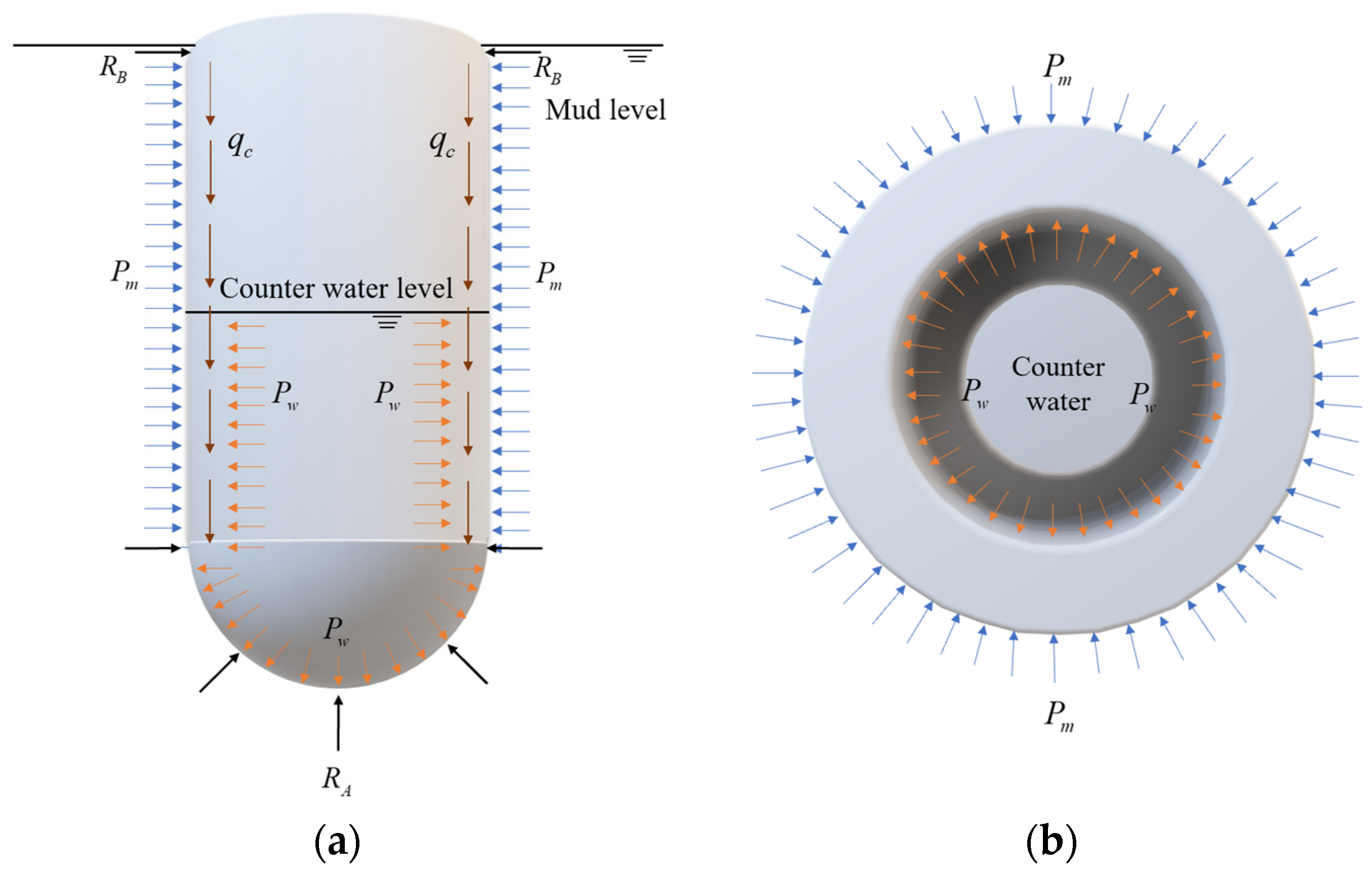

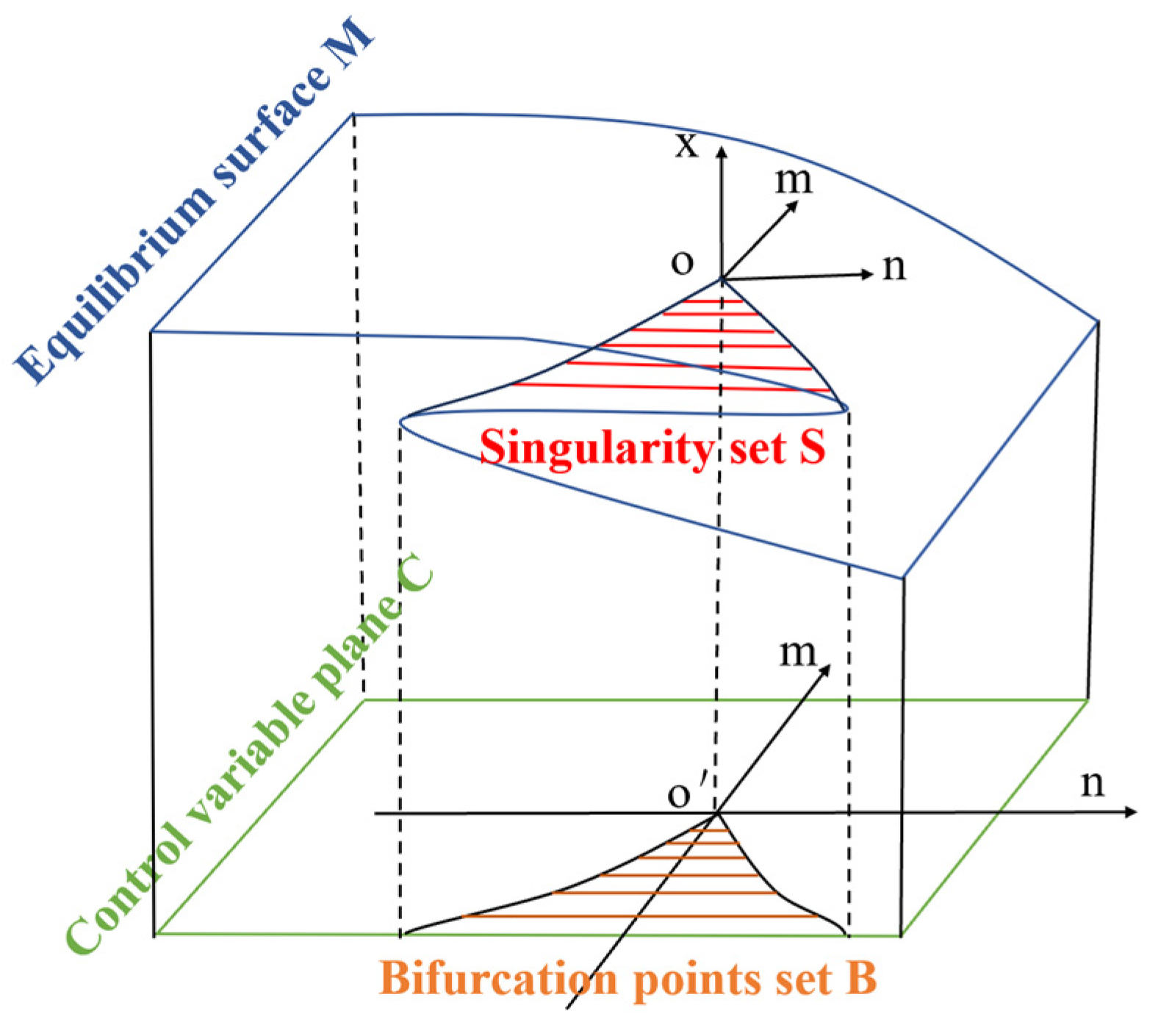
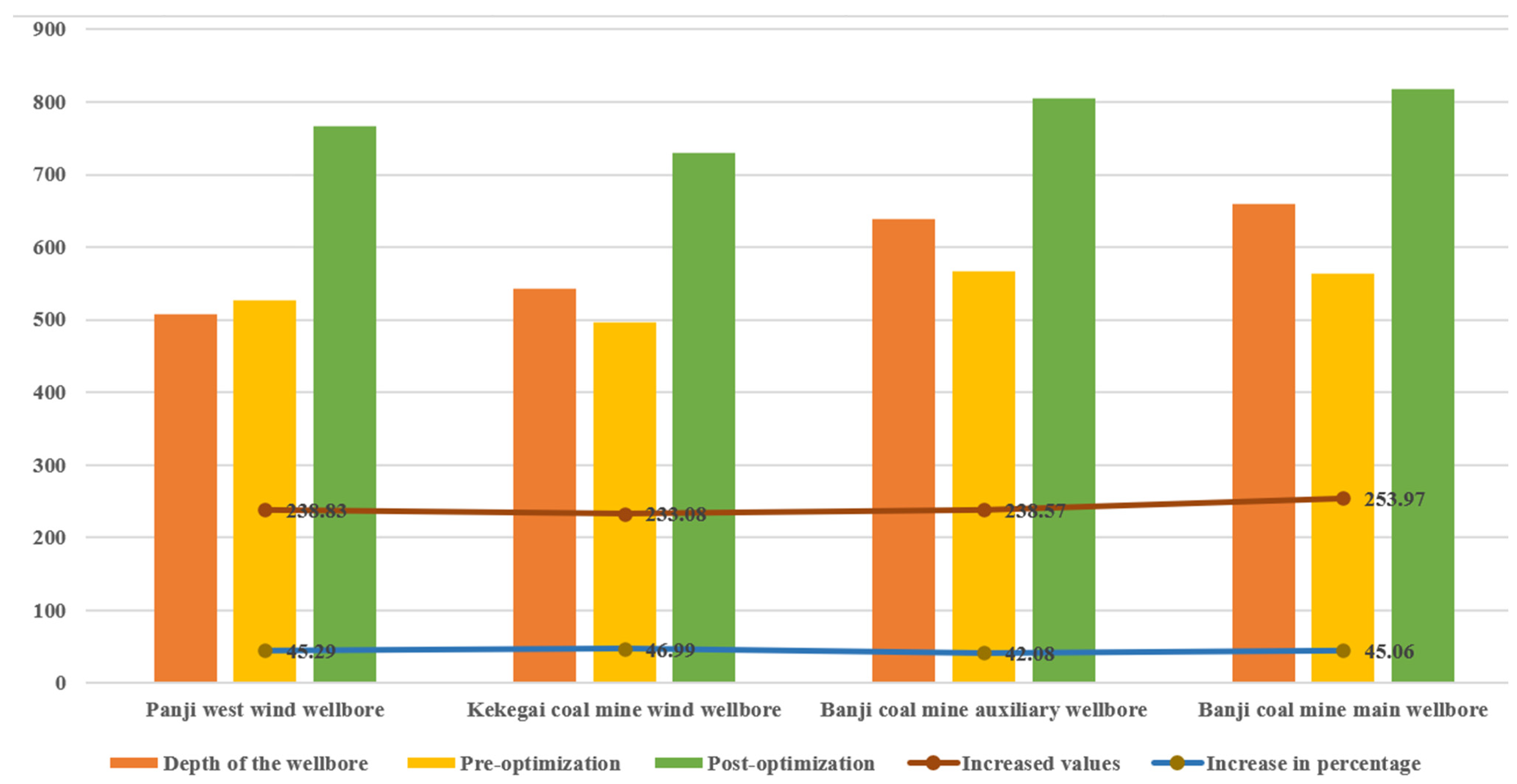

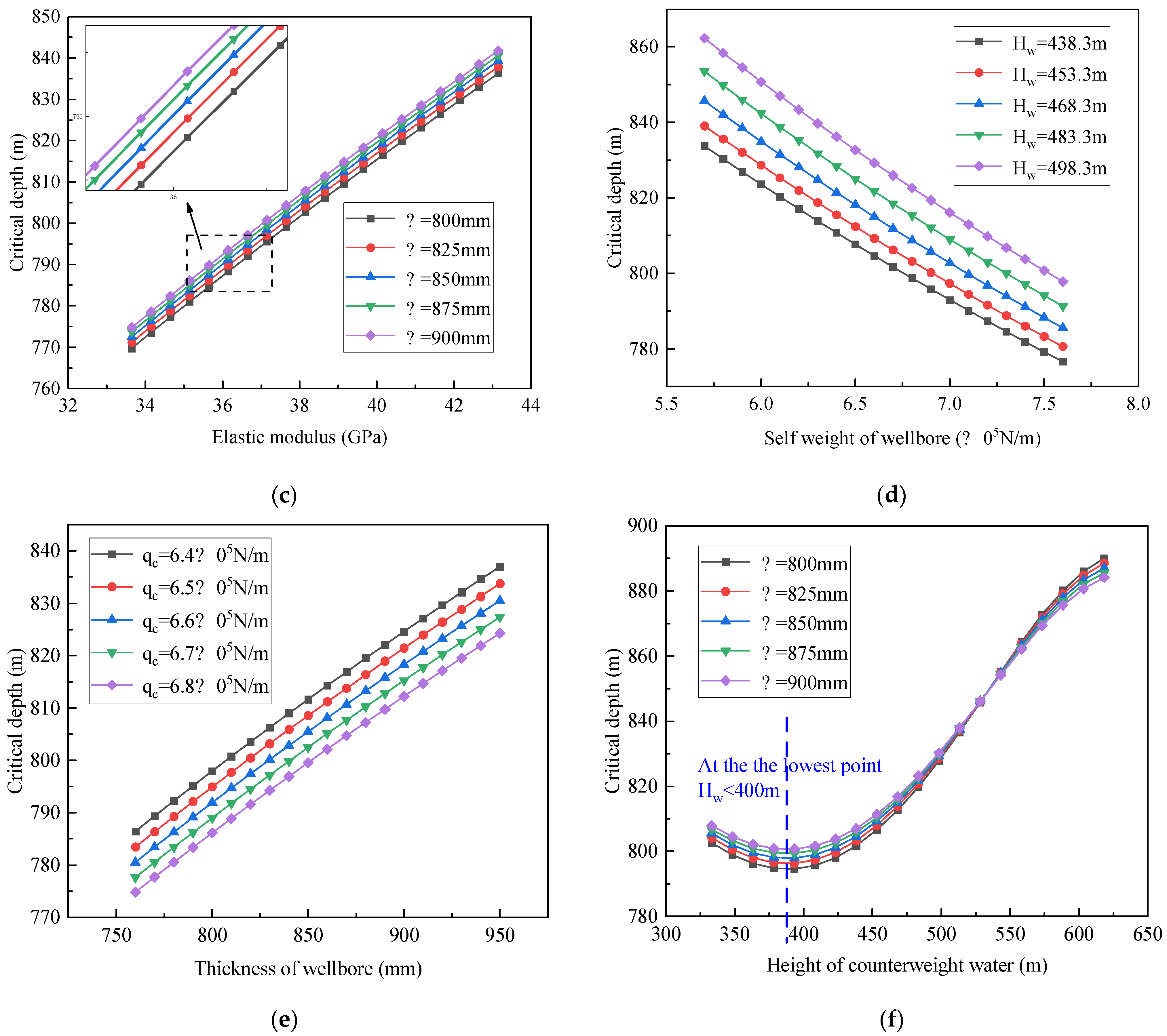
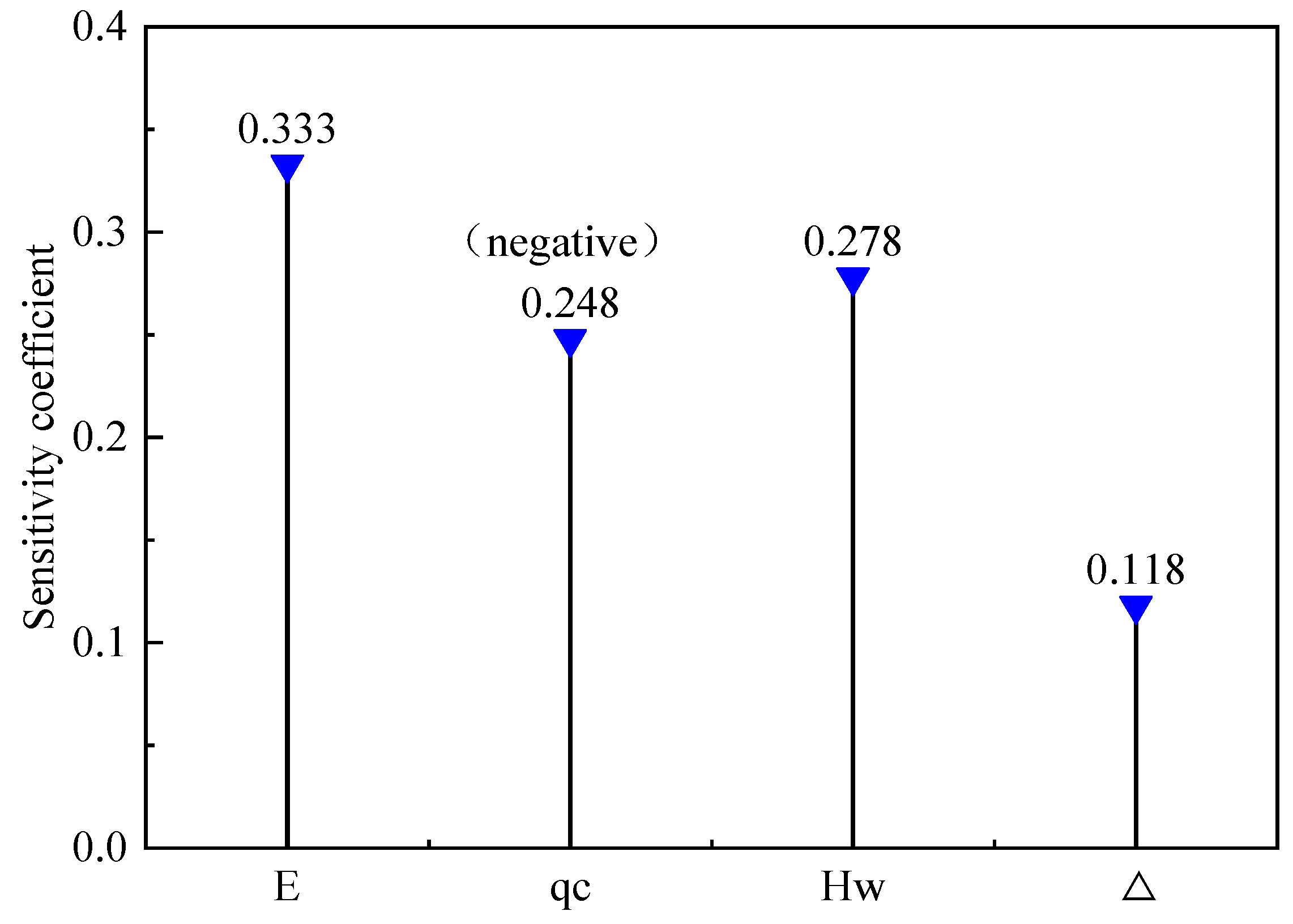
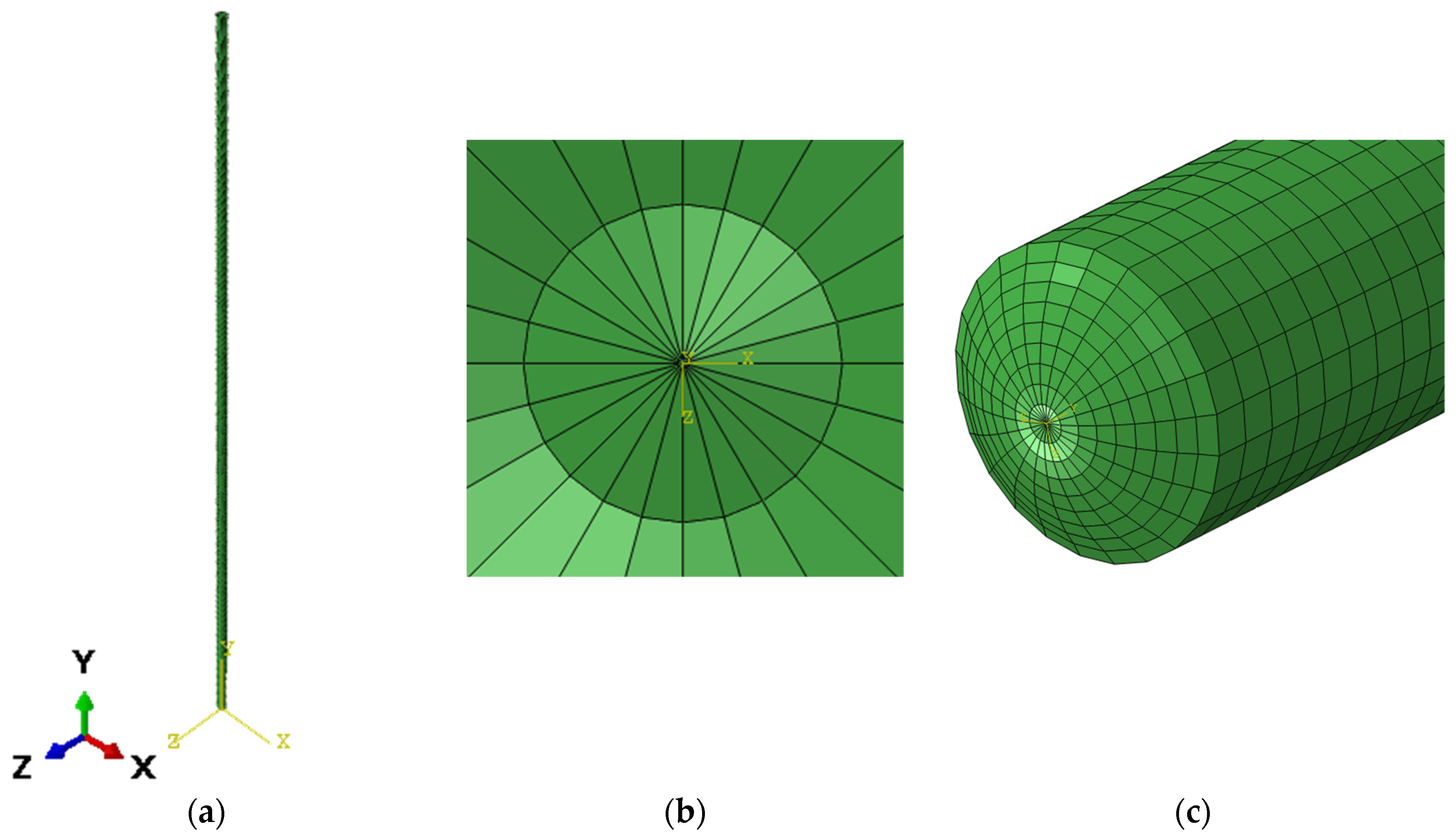
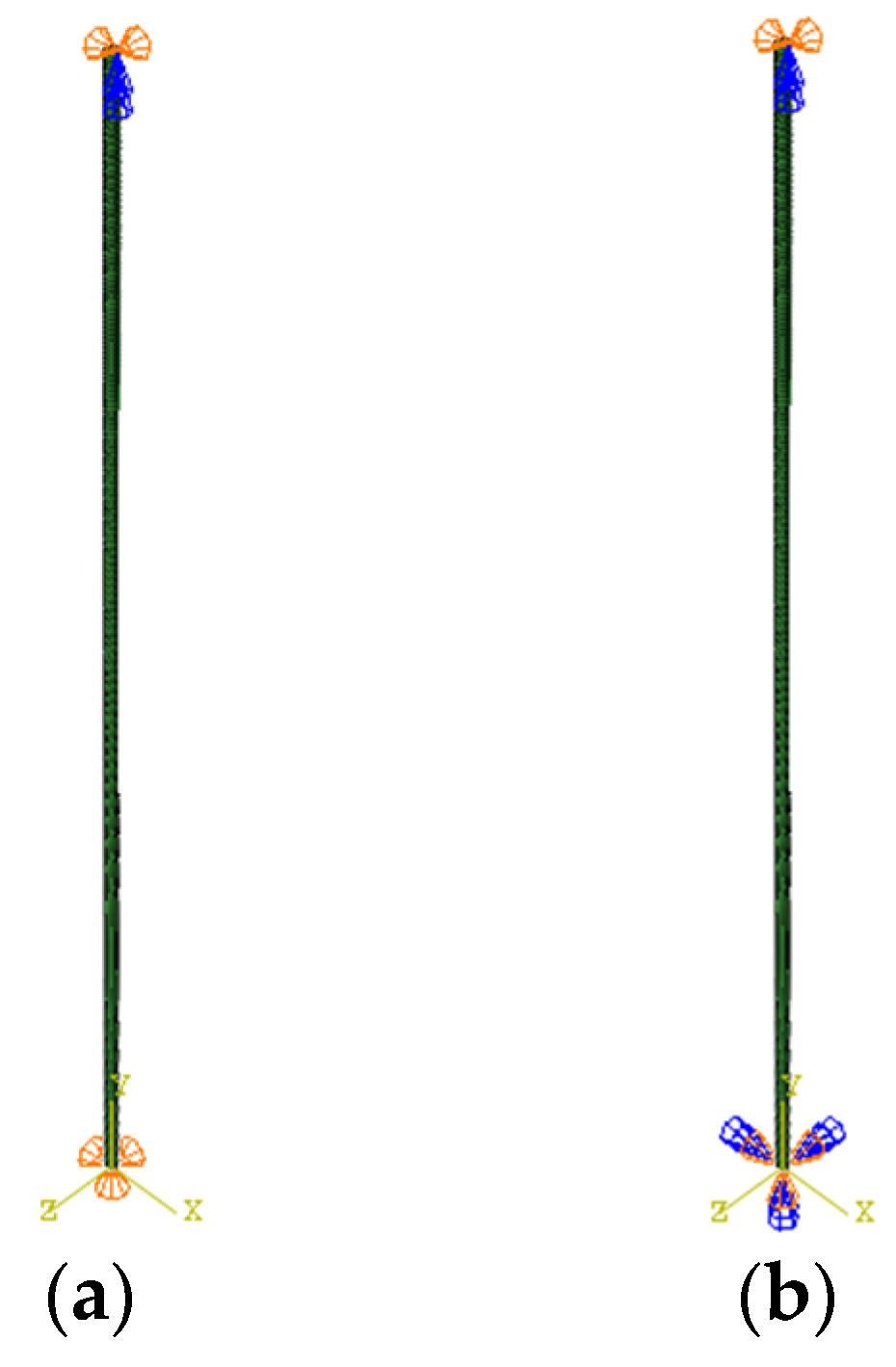

| Symbols | Meanings | Symbols | Meanings |
|---|---|---|---|
| The deflection curve function of wellbore | The total potential energy of wellbore | ||
| The first derivative of | Elastic strain energy | ||
| The second derivative of | Total external potential energy | ||
| The maximum deformation value of the deflection curve | Elastic modulus of the material used for wellbore | ||
| The outer diameter of wellbore | Sectional moment of inertia of wellbore | ||
| The inner diameter of wellbore | The coefficient of | ||
| Radius of curvature | The coefficient of | ||
| The in-plane bending moment | The coefficient of | ||
| The ratio of reinforcement | The state variable of the system | ||
| Self-weight of wellbore | A control variable of the system | ||
| Lateral pressure of mud on the external surface of wellbore | A control variable of the system | ||
| Lateral pressure of counterweight water on the internal surface of wellbore | The first derivative of | ||
| Counterforce on the bottom of wellbore | The second derivative of | ||
| The counterforce of wellhead support | The external potential energy change due to self-weight | ||
| Depth of wellbore | The change in external potential energy due to the lateral pressure of mud | ||
| The weight of concrete | The change in external potential energy under the lateral pressure of counterweight water | ||
| The weight of steel | The horizontal component of | ||
| The weight of mud | The vertical component of | ||
| Gravity of mud per unit length on the outside of wellbore. | The horizontal component of | ||
| The weight of counterweight water | The vertical component of | ||
| Gravity of counterweight water per unit length on the inside of wellbore. | Stability criterion | ||
| Height of counterweight water | Thickness of wellbore |
| Traditional Methods | Optimized Methods | |
|---|---|---|
| Restrictive conditions | With both ends hinged | Upper end hinged lower end fixed support |
| Sources of information | Literature [23] | Equation (36) |
| Critical depth formulas |
| Shaft Walls | Panji West Wind Wellbore | Kekegai Coal Mine Wind Wellbore | Banji Coal Mine Auxiliary Wellbore | Banji Coal Mine Main Wellbore |
|---|---|---|---|---|
| Sources | Literature [30] | Literature [31] | Literature [32] | Literature [23] |
| (GPa) | 35.5 | 38.89 | 38.15 | 38.85 |
| (m4) | 126.5 | 68.26 | 203.33 | 139.66 |
| (m) | 9 | 7.2 | 9.3 | 8.3 |
| (m) | 7 | 6 | 7.6 | 6.5 |
| (N/m) | 457,008 | 328,159 | 660,000 | 469,000 |
| (N/m) | 376,957 | 276,948 | 444,348 | 351,000 |
| (m) | 222.2 | 215.2 | 333.3 | 291.703 |
| Depths of wellbore (m) | 508 | 542.5 | 638.084 | 659.675 |
| Critical depths under the traditional method (m) | 527.28 | 495.98 | 566.95 | 563.58 |
| Stability under the traditional method | Stable | Unstable | Unstable | Unstable |
| Critical depths under the optimized method (m) | 766.11 | 729.06 | 805.52 | 817.55 |
| Stability under the optimized method | Stable | Stable | Stable | Stable |
| - | ||||
| - | - | |||
| - | - | - | ||
| - | - | - | - |
| Construction Techniques | Constraints on BOTTOM | Constraints on TOP |
|---|---|---|
| Traditional construction technology | U1, U2, U3 | U1, U3, UR2 |
| Optimized construction technology | U1, U2, U3, UR1, UR2, UR3 | U1, U3, UR2 |
Disclaimer/Publisher’s Note: The statements, opinions and data contained in all publications are solely those of the individual author(s) and contributor(s) and not of MDPI and/or the editor(s). MDPI and/or the editor(s) disclaim responsibility for any injury to people or property resulting from any ideas, methods, instructions or products referred to in the content. |
© 2024 by the authors. Licensee MDPI, Basel, Switzerland. This article is an open access article distributed under the terms and conditions of the Creative Commons Attribution (CC BY) license (https://creativecommons.org/licenses/by/4.0/).
Share and Cite
Pan, R.; Liu, J.; Cheng, H.; Fan, H. Study on the Vertical Stability of Drilling Wellbore under Optimized Constraints. Appl. Sci. 2024, 14, 2317. https://doi.org/10.3390/app14062317
Pan R, Liu J, Cheng H, Fan H. Study on the Vertical Stability of Drilling Wellbore under Optimized Constraints. Applied Sciences. 2024; 14(6):2317. https://doi.org/10.3390/app14062317
Chicago/Turabian StylePan, Ruixue, Jimin Liu, Hua Cheng, and Haixu Fan. 2024. "Study on the Vertical Stability of Drilling Wellbore under Optimized Constraints" Applied Sciences 14, no. 6: 2317. https://doi.org/10.3390/app14062317
APA StylePan, R., Liu, J., Cheng, H., & Fan, H. (2024). Study on the Vertical Stability of Drilling Wellbore under Optimized Constraints. Applied Sciences, 14(6), 2317. https://doi.org/10.3390/app14062317






